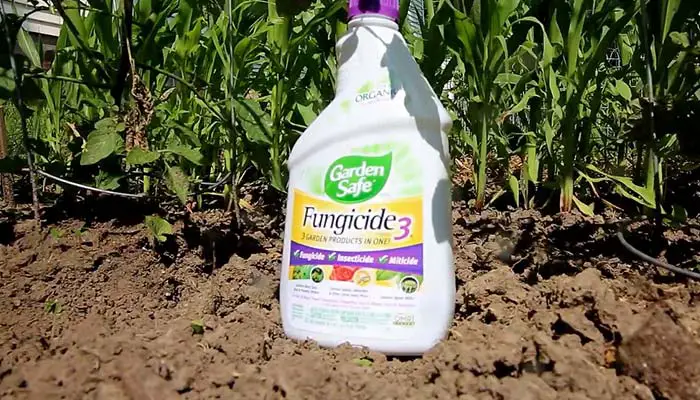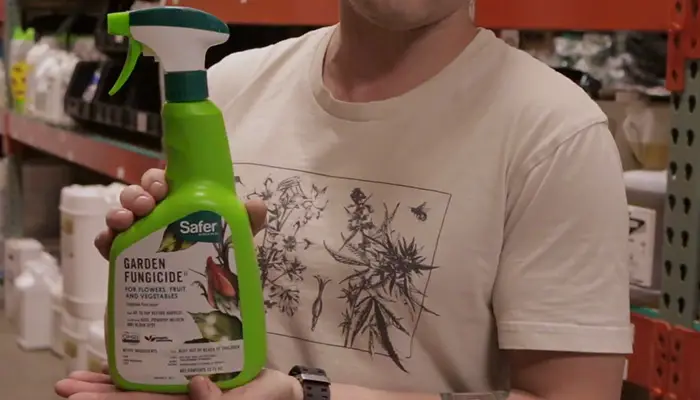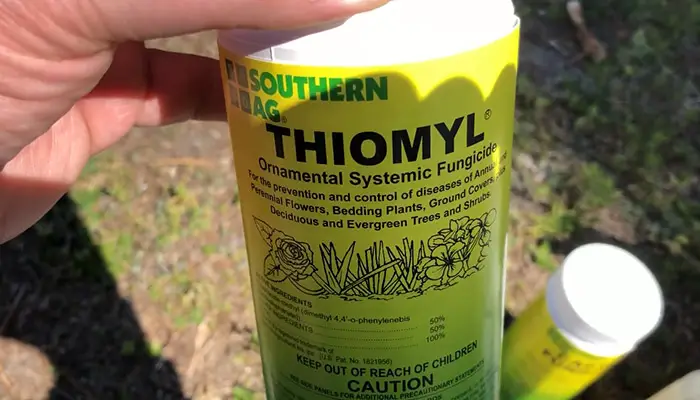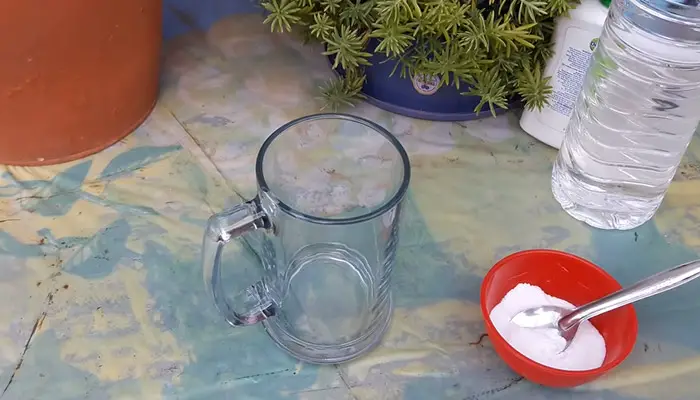Do you know what my favorite thing about Peonies is? These blooms have mesmerizing hues.
Peony comes in every hue except blue, which is unusual. I might be a bit disappointed because blue is my favorite color, but nothing compares to the anxiety I feel when my Peonies are attacked by fungus.
Fungal attack not only kills the plant slowly but also destroys its exterior beauty and vitality. That’s why, if you notice symptoms or suspect a fungal infection, get up. Prepare your gears and check out my list of the best fungicides for peonies.
To assess my recommendations, you must know which fungicides are perfect for Peonies. Shortly, look for fungicides with active ingredients like Copper Octanoate, Chlorothalonil, Sulfur, Neem Oil, Captan, etc.
Anyway, let’s get started with my review.
Top Fungicide For Peonies- Comparisons
| Fungicide | Active Ingredient | Form | Type | Price |
|---|---|---|---|---|
| Bonide Copper Fungicide | Copper Octanoate | Concentrate | Organic | |
| Bonide Fungal Disease Control | Chlorothalonil | Ready-To-Spray | Synthetic | |
| Garden Safe Brand Fungicide | Neem Oil | Ready-To-Spray | Organic | |
| Bonide Fungal Disease Control | Mancozeb | Concentrated | Synthetic | |
| Southern AG Fungicide | Captan | Wettable Powder | Synthetic | |
| Safer Garden Fungicide | Sulfur | Concentrated | Organic | |
| Southern AG Systemic Fungicide | Thiophanate Methyl | Wettable Powder | Organic |
Top 7 Fungicide For Peonies- Reviews
1. Bonide Copper Fungicide

A list of the best fungicides without BONIDE is incomplete. This firm has been providing a comprehensive variety of high-quality synthetic and organic gardening supplies since 1926. And Copper fungicide is certainly one of the company’s most popular products.
Active Ingredient
Copper Soap is the common term for the active component, although the chemical name is Copper Octanoate (10%). It is the primary driving power, having a metallic copper equivalent of 1.8%.
However, Copper Octanoate inhibits the internal metabolic activities of fungal cells by denaturing the functioning proteins and enzymes. Thus, it protects your Peony against fungal infection.
Form & Type
It comes in a white jar with a blue-colored liquid that is organic in origin, much like the rest of the BONIDE goods. I believe organic gardeners will appreciate it.
Mode of Action
Copper Octanoate naturally acts as a contact fungicide. Once you apply it to the leaves of Peonies, the droplets form a shield on the leaves’ surface. This barrier protects against future fungal infections while also killing any existing fungus on the leaf surface.
Due to its preventive nature, it is advisable to use it before a fungal attack or as soon as the symptoms appear.
Key Features
Bonide Copper Fungicide can be used on over 150 different plants, including ornamentals, roses, lawns, vegetables, and fruits. It’s amazing that it can protect so many plants against fungal diseases like powdery mildew, downy mildew, black spot, peach leaf curl, rust, and others.
Why for Peonies
Though Peonies are mesmerizing, they are susceptible to a bunch of fungal diseases. But the good news is, Bonide Copper fungicide can control most of the common diseases of Peonies like Botrytis Blight, Leaf Blotch, Phytophthora Blight, Powdery Mildew, Verticillium Wilt, White Mold, Anthracnose, etc.
Additionally, the naturally occurring copper ensures not much residual toxic effect & thereby, preserves the divine beauty.
Applying Procedure
Mix 0.5 to 2 fluid ounces of the concentrate with 1 gallon of water. For a more specific dose, check out the product label. As a preventive measure, apply this fungicide every 7-10 days.
2. Bonide Fungal Disease Control

Another top-rated Bonide product is Fung-onil Multi-purpose Fungicide. Before making a purchase, I always peruse the review sections to see what others have to say. There was not a single negative review, which was surprising!
Active Ingredient
The major ingredient in this fungicide is 0.087% chlorothalonil. The rest of the substances are largely synthetic, even though Chlorothalonil is an organic molecule. As a result, the fungicide is classified as synthetic in general.
Interestingly, Chlorothalonil’s functioning concept is quite simple yet effective. It inhibits metabolic activity by targeting the fungal spores’ internal enzyme system. As a result, the cell membrane is ruptured, resulting in death or dormancy.
Form & Type
You will receive a white bottle containing milky liquids if you purchase it. But the good news is that it’s Ready-to-Spray, which makes your work easier. Although, the product is also available in a concentrated version.
Mode of Action
Chlorothalonil too is a contact fungicide. Thereby, when it comes into contact with fungi during the application, it regulates them.
Key Features
First of all, the Fung-onil fungicide is a broad-spectrum fungicide. That is to say, it is not discriminating when it comes to killing. It seeks to kill anybody (fungi) with whom it comes into contact.
Second, it is a multipurpose fungicide that may be used on a variety of plants in your garden, including vegetables, fruits, flowers, shrubs, ornamentals, and trees.
Why for Peonies
As Peonies are mostly bushes, Ready-to-Spray fungicides are simple to apply for a complete treatment. It also protects against black spots, botrytis blights, anthracnose, rusts, powdery mildew, scabs, and other diseases that affect Peonies commonly. So we may conclude that acquiring it is not a bad decision.
Applying Procedure
RTS formulation makes it easier to spray. Just shake before application, plug in the hose pipe & spray on the lower & upper surface of the leaves.
3. Garden Safe Brand Fungicide

Garden Safe Brand Fungicide3 is unquestionably the best natural fungicide for treating your Peonies. “Keep pest and disease control simple and let nature take care of the rest” is the exact thumb rule that the company follows. More details-
Active Ingredient
Clarified hydrophobic extract of neem oil makes up 70% of the mixture, making it the active component. For pest management, neem oil is a common name. It simply covers the fungal cell surface, causing suffocation and cell death. Trust me, there isn’t a more straightforward method of eliminating fungi than this!
Form & Type
Fungicide3 is also available in a white container with a brownish liquid. While spraying, you may sense a garlic odor, but I believe this is normal. As long as the fungicide is 100% natural, a little smell won’t bother you.
Mode of Action
When you spray it on your peony, any pests on the leaf surface will come into touch with the active component and finally die. Furthermore, a single treatment will protect your peonies from new infections for roughly 14 days. After that, you may need to re-spray if necessary.
I believe you realize from the start that it is a contact or preventative fungicide that only acts when the pest comes into direct contact with it.
Key Features
The Garden Safe brand fungicide is a terrific value in and of itself. It not only protects against fungus but also kills and repels hazardous insects and mites. And neem oil, which is a natural insecticide, deserves credit for it.
Because of its three-fold effect, it may be used on all your fruits, vegetables, herbs, spices, flowers, houseplants, trees, shrubs, and even lawns. Powdery mildew, black spot, downy mildew, anthracnose, rust, leaf spot, botrytis, needle rust, scab, twig and tip blight, and Alternaria are among the diseases it combats. On the list, I saw a number of frequent peony diseases.
Why for Peonies
Powdery mildew is a common problem for peonies, and it may be very damaging. The good news is that fungicide3 can address this issue in as little as 24 hours. Furthermore, fungicide3 is toxic to all stages of insects and mites, whether they are eggs, larvae, or adults.
Applying Procedure
It is a Ready-to-Spray formula. Thereby, just shake & spray.
4. Bonide Fungal Disease Control

Bonide shoots again! It’s BONIDE MANCOZEB FLOWABLE with Zinc this time. The term “Mancozeb” is derived from the words Maneb and Zineb. Both are by far the most efficient dithiocarbamate fungicides for a variety of plants. Let’s have a look at how it can help your Peonies-
Active Ingredient
The active element in the fungicide is 37 % Mancozeb. Mancozeb, perhaps, deserves a little more explanation. In a nutshell, it’s a coordination product containing 7.4 % Mn, 0.9 % Zn, and 28 % Ethelene Bisdithiocarbamate ion.
Now, you’re probably curious about how Mancozeb works, right? Well, It inhibits fungal growth by affecting the metabolism of fungal cells. Although the process appears straightforward, I am not gonna bore you with complex molecular reactions, so chill!
Form & Type
Bonide Mancozeb appears as a yellowish liquid in a white container. As it’s concentrated, the liquid is rather thick, and you may detect a sulfur-like stench.
Furthermore, Ethelene Bisdithiocarbamate ion, one of the active components, is not found in nature. Thereby, It can be classified as a synthetic fungicide since it takes up the majority of the space.
Mode of Action
Mancozeb is a contact fungicide with a broad range of activities. As a result, it’s commonly used as a preventative step. When fungi come into contact with Mancozeb, it inhibits the growth, development, and spread of the fungus by inactivating important enzymes and amino acids of the fungal cell.
Key Features
Mancozeb is a tempting bundle that is difficult to pass up. To begin with, it’s a broad-spectrum fungicide that attacks the complete range of fungal groups that can affect your Peonies and other ornamentals, fruits, and crops.
Second, it efficiently combats a variety of fungal diseases such as leaf spots, downy mildew, blights, rusts, scabs, rot, and blotch. Finally, it includes Mn and Zn, which have antifungal properties but are also important for plant nourishment. Now tell me if this isn’t a fantastic offer.
Why for Peonies
Botrytis blossom blight and phytophthora blight are two diseases that plague Peonies frequently. But don’t be worried. Mancozeb will look after them for you.
Applying Procedure
Mix half an ounce of this concentrate per gallon of water & apply after every 7-10 days for the preventive purpose.
5. Southern AG Captan Fungicide

Southern Agricultural Insecticides Inc. has not confined its program only to insecticides. Otherwise, we may have missed a great deal like Captan Fungicide.
Active Ingredient
CAPTAN is a name you may have heard of. In the agriculture industry, it is a commonly utilized chemical component for pest management. It is the active component in this fungicide at a proportion of 50%.
Now you may ask, how does CAPTAN kill fungi? Well, CAPTAN works by interfering with the fungus cells’ energy-producing system, causing them to die over time.
Form & Type
When you open the white bottle, you’ll find a light brown wettable powder within. It’s also an inorganic fungicide that’s occasionally used together with other pesticide formulations.
Mode of Action
CAPTAN is a contact fungicide. It will affect fungal cells only upon direct contact. It will not get absorbed into plant tissue & that’s why you can count it as a preventive fungicide. After applying, it will create a protective barrier on the leaf surface & keep your Peonies protected from further fungal infection.
Key Features
Interestingly, except for oil and very alkaline compounds, this fungicide can be safely and successfully mixed with the most regularly used fungicides and insecticides at specified dose rates. CAPTAN fungicide also covers all of your gardens, which is a fascinating fact. It can be used to sustain fruits and nuts, ornamentals, flowers, and any other type of plant.
However, Anthracnose, Brown rot, Leaf blight, Scab, Twig, Blossom blight, Black rot, Botrytis blossom end rot, Primary scab, etc are the common diseases that CAPTAN can minimize. Isn’t it a rather wide range?
Why for Peonies
The CAPTAN fungicide enhances your plant’s look. So, wouldn’t it be nice to have a gleaming green Peonies plant?
Applying Procedure
The mixing ratio is 1.2-2 tablespoons per gallon of water. Mix it properly & spray.
6. Safer Garden Fungicide

Safer Brand Garden Fungicide is a common product in the grower’s backyard. You can ask your neighbor about it if you haven’t used it before. The point I intend to establish is, this product is a popular choice both for its chemical nature & supreme quality.
Active Ingredient
Sulfur, the active component, makes about 12 % of the fungicide’s 16 fl oz concentrated liquid. Its triple-action is quite effective for fungus control in flowers, fruits & vegetables.
Sulfur fungicides have long been a top focus for organic gardeners. It works simply by affecting the fungal cell membrane first, then hindering cell respiration, causing death, and preventing the germination of fungal spores. It’s no surprise that Safer Garden Fungicide is such a hit!
Form & Type
The bottle comes in a stunning lime green color & the concentration is somewhat yellowish brown. You may detect a faint sulfur odor due to the presence of sulfur, although this is fairly obvious.
Plus, since sulfur occurs naturally, we may categorize Safer Garden Fungicide is an organic product.
Mode of Action
Safer Garden Fungicide is designed specifically for gardeners who actively care for their plants.
It’s vital to remember that the fungicide acts by contact, which means that once your plants are severely diseased, the treatment will do nothing but prevent subsequent infections. Therefore, you must evaluate your plants on a regular basis and begin treatment before any harm develops.
Key Features
A comprehensive garden includes flowers, ornamentals, fruits, vegetables, and other plants. Guess what? Safer Garden fungicide applies to all of them. Interestingly, the fungicide is quite effective against common fungal illnesses like powdery mildew, leaf spot, black spot, and rust. It’s like having a one-stop shop for all of your gardening issues.
Additionally, this 16 fl. Oz. recipe may be scaled up to 4 gallons & depending on the sort of plant you’re treating, this complete bottle will cover up to 2,400 square feet.
Why for Peonies
When your peony leaves start to turn brown, black, or yellow, Safer Garden Fungicide works out great. Though fungus is not always to blame for these symptoms, it is commonly the case. Powdery mildew is worth mentioning since it can be completely cured with this therapy.
Applying Procedure
Mix 2 fl. oz. (4 tbsp.) per gallon of water for Powdery Mildew and 4 fl. oz. (8 tbsp.) per gallon of water to control Black Spots, Leaf Spots, and Rust.
7. Southern AG Thiomyl Ornamental Systemic Fungicide

Another product of Southern AG comes by. The specialty is that it is specific to ornamentals like Peonies. Plus, its effective but safe action of disease control seems perfect for home gardens. More information-
Active Ingredient
A 50% Thiophanate Methyl molecule powers this fungicide. Following application, it penetrates plant tissue and changes to MBC, a distinct chemical (2-benzimidazole carbamate). This MBC then binds to tubulin, a protein present in fungal cells, effectively stopping cell division and restricting reproduction and spread.
Form & Type
Thiophanate Methyl is an organic component that makes up half of the entire composition. Therefore, we may presume it’s an organic fungicide.
However, you could be wondering what you receive from the inside. Well, when you unscrew the cap from the white bottle, you’ll notice a grayish-white powder and a faint sulfur odor.
Mode of Action
Thiophanate Methyl is a systemic fungicide. The beauty of systemic fungicides is they protect leaves that have not emerged yet. Upon application, it gets absorbed into the plant tissue within some time & deals with the inside dwellers.
Key Features
Some fungicides target specific fungi, whereas others kill all fungi that come into contact. Thiomyl is the second one. That’s why it’s known as a broad-spectrum fungicide. In a systematic controlling process, it demonstrates both preventative and curative aspects.
Now, let’s have a look at which plants Thiomyl can cover. It may be used on practically all of your garden’s ornamental plants. This fungicide is applicable to all your annual and perennial flowers, bedding plants, foliage plants, ground coverings, evergreen trees, and shrubs. So, what do you have to lose?
Why for Peonies
Firstly it can treat your Peony bulbs for overwintering & thus give you a disease-free planting material. Secondly, Thiomyl controls common Peony diseases like Botrytis Blight, Leaf Blotch, Phytophthora Blight, Powdery Mildew, White Mold, Anthracnose, etc.
Along with these, this fungicide can cure nearly 15 major diseases of ornamentals. So, anyone would be wise to have it.
Applying Procedure
For most uses, 2.75-3 teaspoons per gallon of water are used. You can check the label for specific doses.
Homemade Fungicide for Peonies

It is not always necessary for a highly efficient contact fungicide for Peonies to be of a well-known brand. Sometimes It is something you can do on your own. Here’s an illustration:
Ingredient
- Baking Soda
- Dish-washing Liquid
- Olive oil
Procedure
1 tablespoon of each of the three components should be added to 500 mL of water and thoroughly mixed. Your fungicide is all set to go.
Fungal Diseases of Peonies

The hue of the fungus’s patches is a key to detecting fungal diseases on Peony. It might be black, reddish, or gray in appearance, with a golden ring surrounding the spot. This is the first stage of disease development, and it is also the best period to control it.
However, fungal diseases have been termed either by following the name of the causative agent or by following the symptoms. Botrytis blight, Crown gall, Leaf blotch or measles, Phytophthora blight, Powdery mildew, Root rot, Southern blight, White mold, etc are some of the most frequent peony fungal diseases.
How to Get Rid of Fungus on Peonies

To get rid of fungus on peony, you’ll need to plan ahead. Preventive measures would be continual action. And once the disease has been established, you may need to use chemicals to treat it. Now the question, what would be the preventative measures?
Well, maintaining excellent air circulation is one of the most common metrics. At the end of the season, remove and discard all plant debris as soon as possible. It’s also a good idea to avoid overhead watering and injuring plants at or near the soil line. Finally, keep the humidity low to avoid fungal development and infection.
Conclusion
The lovely scent of Peonies may entice you, but the diseased foliage and blossoms are unlikely to do so. The fungal attack is a concern for both indoor and outdoor-grown Peonies, and then, you will undoubtedly miss your healthy, colorful Peonies.
Since you’re the one with the hands, it’s your responsibility to keep them safe, and make no mistake, my buddy. Choose wisely and spend wisely. That was all I had to say. Best wishes.
